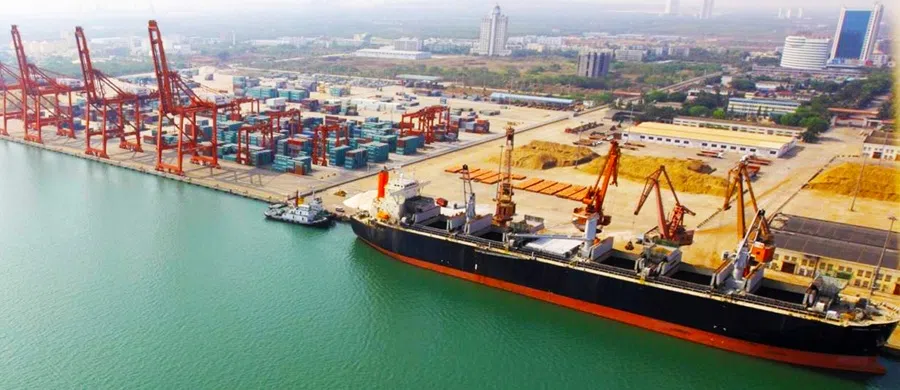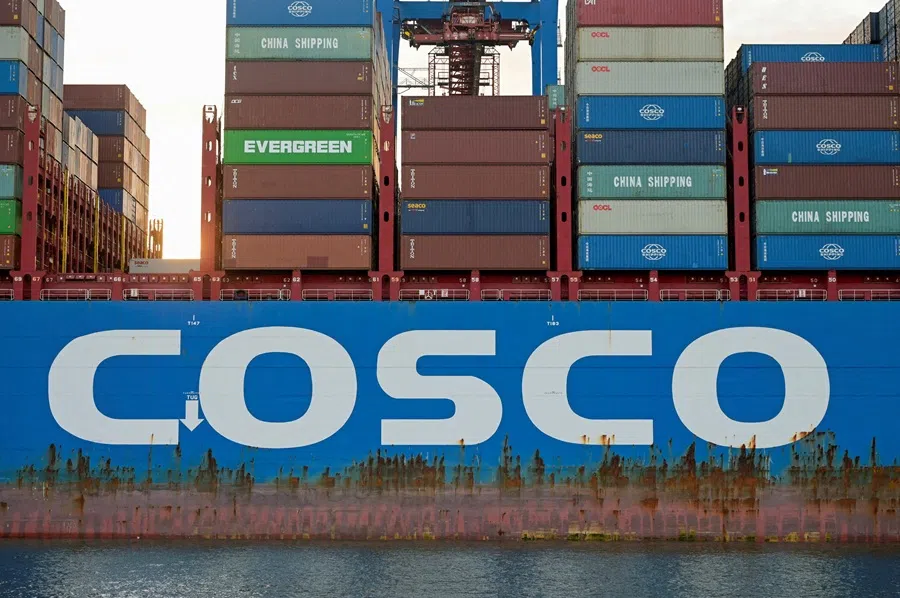How China’s COSCO is redrawing global shipping routes through Southeast Asia
China’s COSCO has launched a new direct shipping route linking Batam, Indonesia, and Yangpu, Hainan, enhancing regional trade, diversifying supply chains, and boosting Batam’s role amid growing US-China competition and shifting global maritime dynamics. Researcher Genevieve Donnellon-May explores its implications.

Last month, Xinhua News reported the inaugural voyage of a new direct shipping route operated by China’s state-owned COSCO, linking Batam in Indonesia to Yangpu Port in Hainan, with stops at Kota Kinabalu in Malaysia.
While vessel details remain undisclosed, Chinese media highlighted the strategic significance: the route integrates Batam and Yangpu — Hainan’s key maritime hub — into COSCO’s extensive global network, while enabling faster connections to North and South America. Doing so creates a faster shipping route spanning Southeast Asia, China and the Americas.
This enhances Indonesia’s role in intra- and inter-regional trade flows, while further establishing Batam as a key destination for foreign direct investment and an emerging cargo hub.
Bilateral ties
At the bilateral level, it reinforces the partnership between China and Indonesia, two BRICS members, which are commemorating 75 years of diplomatic relations this year. Indonesia, Southeast Asia’s largest economy, has also been a Belt and Road Initiative (BRI) participant since 2017.
Two-way trade is expanding. In 2024, China was Indonesia’s largest trading partner for the 12th consecutive year. Last year, bilateral trade reached US$147.8 billion, a year-on-year increase of 6.1%, according to China’s General Administration of Customs. China’s exports to Indonesia totalled US$76.7 billion, up 17.6% year-on-year. China is also a major partner and investor in strategic sectors in Indonesia, like mining, electric vehicles and infrastructure. High-level engagements, including Indonesian President Prabowo Subianto’s recent visit to Beijing, have resulted in various agreements.
Indonesia’s new trade route
The Batam-Hainan direct shipping route delivers substantial economic and strategic benefits for both China and Indonesia.
For Indonesia, Batam lies at the heart of this development. Once a fishing island, it became one of the country’s earliest industrial zones and a free trade zone in 2009, embedding it in regional supply chains and the Riau Islands-Singapore-Malaysia “Growth Triangle”. In 2024, Batam Port handled around 670,000 twenty-foot equivalent units (TEUs).

Linking Batam with Hainan’s free trade port shortens transit times, lowers logistics costs, and strengthens competitiveness in the Chinese market. By connecting Yangpu Port’s mainline services to the Americas, the new shipping route offers Indonesian exporters, particularly those from Batam, faster and cheaper access to North and South American markets, thereby bypassing their traditional reliance on Singapore. This enhances Indonesia’s role in intra- and inter-regional trade flows, while further establishing Batam as a key destination for foreign direct investment and an emerging cargo hub.
The new Batam-Hainan corridor can help diversify trade routes, enhance supply chain resilience, and reduce dependence on US-controlled or volatile maritime passages...
Beijing expands Indo-Pacific reach
There are benefits for Beijing, too. Aside from boosting local development in Hainan, a free trade port and logistics hub, the initiative serves multiple domestic and external objectives. Domestically, it provides outlets for industries plagued by overcapacity (such as photovoltaics) by enabling surplus goods to be exported efficiently to more markets. Externally, the route reflects Beijing’s broader push to deepen trade, flows of goods and capital, and supply chain integration with Southeast Asia — a key trading partner — amid global trade fragmentation.
The shipping also addresses China’s longstanding “Malacca Dilemma”. Roughly two-thirds of China’s maritime trade passes through the Malacca Strait, a chokepoint vulnerable to disruption in times of crisis or geopolitical tension. The new Batam-Hainan corridor can help diversify trade routes, enhance supply chain resilience, and reduce dependence on US-controlled or volatile maritime passages, while maintaining access to regional and global markets amid tariffs and trade tensions.
For Beijing, the route consolidates regional presence, supports ASEAN development priorities, and extends China’s influence over Southeast Asian trade networks, securing maritime routes amid tensions in the South China Sea and the wider contested Indo-Pacific. It also strengthens China’s geoeconomic and geopolitical reach by enabling faster trade with Southeast Asia, North America, and South America, while advancing the BRI across these regions.
Reshaping trade flows regionally and globally
The Batam-Hainan shipping route extends beyond bilateral trade, embedding Batam into COSCO’s global network spanning Africa, Oceania, and Europe, while strengthening China-Southeast Asia connectivity. Goods from Batam can now reach China more efficiently and gain faster access to North and South America via Yangpu Port, positioning Southeast Asia as both a growing production base and a key transit hub in global supply chains.

The timing amplifies its significance. The recent ASEAN-China Free Trade Agreement upgrade (ACFTA 3.0) prioritises digital trade, green growth, and supply chain resilience. By enabling firms to leverage ACFTA 3.0’s upgraded framework, the Batam-Hainan link advances regional economic integration across a combined market of more than two billion people in over ten countries.
Equally important are its effects on intra-and inter-regional trade. Intra-regionally, the linking of Batam, Hainan, and Kota Kinabalu reinforces ASEAN integration and trade with China. Inter-regionally, Yangpu Port’s role as a transshipment hub streamlines Southeast Asia’s access to North and South American markets, cementing the region’s role as a key node in global supply chains.
By reducing reliance on strategic chokepoints such as the Malacca Strait, the route enhances ASEAN’s resilience and bargaining power, giving member states — particularly Indonesia and Malaysia — greater flexibility amid intensifying US–China competition.
Enhances ASEAN’s resilience and bargaining power
Strategically, the corridor recalibrates regional connectivity by creating an alternative pathway that complements Singapore-centred networks. This aligns with the Master Plan on ASEAN Connectivity 2025, which emphasises diversified infrastructure to support trade and economic growth.
By reducing reliance on strategic chokepoints such as the Malacca Strait, the route enhances ASEAN’s resilience and bargaining power, giving member states — particularly Indonesia and Malaysia — greater flexibility amid intensifying US–China competition.
Linking to Yangpu Port while maintaining access to American markets allows Indonesia and other Southeast Asian countries to balance economic ties with both powers and diversify partnerships, broadly reflecting the region’s hedging strategy outlined in the ASEAN Outlook on the Indo-Pacific.
Globally, the initiative carries clear strategic weight. By reshaping shipping routes and logistics infrastructure, Beijing demonstrates how connectivity can function as a tool of influence, underscoring the growing role of economic corridors in great power competition. For Washington and its allies, China-centred corridors and maritime infrastructure control — particularly in the contested South China Sea — will remain a source of concern.
Challenges
The Batam-Hainan shipping route faces hurdles. Aside from geopolitical and geoeconomic concerns like Beijing’s increasing influence and presence in Southeast Asia, infrastructure is also another constraint.
Singapore’s entrenched position as the world’s largest transshipment hub — means that the new shipping route complements rather than rivals it.
Although Batam’s port capacity has grown, it still lags far behind Singapore in scale, automation, and connectivity. For instance, Singapore’s new Tuas Mega Port – an ongoing multi-phase project designed to be the world’s largest and first fully automated port, aims to handle 65 million TEUs annually by the 2040s.
Singapore’s entrenched position as the world’s largest transshipment hub — means that the new shipping route complements rather than rivals it. In this light, without substantial upgrades to Batam’s port facilities, customs processes, and digital systems, efficiency gains may be limited.

Regulatory and institutional factors — such as bureaucratic red tape, shifting regulations, and uneven enforcement — as well as operational frictions present further challenges. Inconsistent customs protocols, weak cross-border coordination, duplicative documentation, and gaps in digital integration can slow shipments across regions.
The Batam-Hainan corridor underscores how infrastructure and connectivity projects are increasingly shaping the balance of economic and strategic power in Southeast Asia. While its success will depend on overcoming challenges, the route highlights China’s expanding geoeconomic reach and ASEAN’s growing role as a pivotal hub in global trade networks.



![[Big read] China’s 10 trillion RMB debt clean-up falls short](https://cassette.sphdigital.com.sg/image/thinkchina/d08cfc72b13782693c25f2fcbf886fa7673723efca260881e7086211b082e66c)

